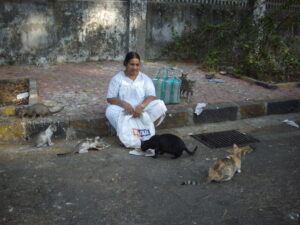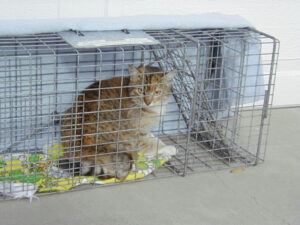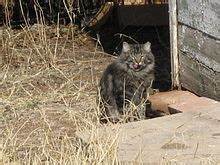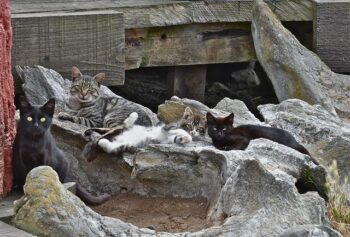TNR (Trap-Neuter-Return) represents a humane way to manage growing feral cat populations. When researching TNR, I discovered that many communities in the United States have posted articles about their TNR feral cat programs. I find this information most satisfying.
Feral cats typically live in a group called a colony. For a TNR program, they are trapped and brought to a vet clinic. There, they are spayed or neutered, vaccinated for rabies if considered appropriate,

and ear-tipped for identity purposes. Then, once they recover from the surgery, they get returned to their original territory.
Now that the cat can no longer reproduce, the colony slowly declines in population. The noise of mating which can disturb human listeners stops, and quiet reigns. Odor from unaltered males’ spray also stops. The cats become healthier.
However, since the cat population still occupies the territory, rodent control continues.
Are These Programs Widely Available In The United States?
In the United States, TNR programs have become widespread. The reason: This method works. Long usage of trap and kill methods indicates that this method does not take care of the problem.
Cat overpopulation does not become reduced by trap and kill. The reasons: There are too many cats and not enough animal control resources. With one group of cats gone, more come in to fill that space. Laws creating feeding bans or laws regulating cat owners make no difference.
People would much rather help animals in need and see a TNR program in effect than to see animals killed. Those communities having a TNR program in place now begin to see dramatic drops in cat intake and euthanasia at animal shelters.
Even in New York City, TNR organizations play active parts in facilitating these drops in numbers. If you want more information about how this system works in the city, go to tnrwebpage@health.nyc.gov.
If this method works in New York City, why won’t it also work in urban areas of Australia? There must be people there who care about the mass slaughter of these animals. I am outraged that Australia considers trap and kill a viable solution.
I watched a little bit of a video from Australia, showing a lovely-looking feral cat in a trap. Was he really a feral cat? He acted more like someone’s abandoned pet. He didn’t seem frightened or traumatized by the cage. He seemed quite calm, and merely curious about the man who came up to the cage, put a gun against the cat’s head and killed him.
If I’d been there, I’d have taken the cat home with me. Of course, I couldn’t take all the Australian cats home, but seeing that beautiful animal cold-heartedly shot did not make my day, and that’s an understatement.
How Do You Define A Community Of Cats?

These cats live outdoors with no specific owner. They might be friendly toward humans or, as feral animals, unsocialized and avoiding humans. They might fall somewhere in between friendly and feral. Some community cats have a caregiver who provides food, water, and shelter if needed, and who watches out for them.
These cats, for the most part, can not adjust to life around humans as an indoor pet. Often fearful and avoiding human contact, they will never make a good lap cat. Do not bring such a cat to a shelter, as the only outcome for it there will be
euthanasia.
Instead, find a TNR program which will give the cat some protection from such an extreme measure.
TNR Lowers Cat Population Numbers More Effectively Than Trap And Kill
You will see many benefits from a TNR program. These include:
- Reduction of shelter admissions and operating costs
- They create a safer community and promote public health
- The program lowers the number of unvaccinated cats
- Improves the life of free-roaming cats
- Can reduce or eliminate behaviors of the cats that can lead to noise complaints
Because TNR eliminates the need for euthanization of these cats in shelters, the animal control facilities can take advantage of resources not available to shelters using trap and kill policies.

Having a caregiver monitor the community of cats frequently allows that person to identify new cats joining their group. Then the newcomer can also receive a TNR treatment.
Each habitat has a maximum capacity for newcomers, determined by sources of food, water, and shelter. When one removes a portion of the population, the remaining animals will respond by increased birthing of kittens.
Though trap and kill can remove cats from a given area, the cat population will rebound to its original level, causing a need for more trapping and killing. New cats will quickly fill the diminished population numbers and will breed more cats to fill the void.
Scientific studies at communities with TNR programs show that TNR reduces and stabilizes cat populations. In 1990, Alley Cat Allies began bringing this program, already successful in the UK, to the United States.

Alley Cat Allies launched a national movement, sharing educational materials, holding regional workshops, locating and enlisting advocates, and rewriting laws. After much hard work, the TNR movement has become mainstream.
Bring TNR To Your Community
If you would like to see such a program started in your community, Alley Cat Rescue can show you
how to do it. They give a seven-step program on how to implement a TNR program. Here is an overview of the steps you’ll need to take:
- Gather baseline statistics so you can assess your community
- Build your staff, do workshops, find volunteers, gather data for other changes
- Set policies and establish a trapping plan
- Establish a funding plan
- Have a veterinarian care plan in place
- Organize community outreach to educate and create community support
- Evaluate your progress

Each of these points requires action steps to facilitate them properly. In their description of the program, Alley Cat Rescue describes all the data you must gather and use to put every step in place. Please read the full article at alleycat.org if you need this information. You will find the link to this reference at the end of this post, under “References I used…”
Learn how you can become part of this compassionate movement. There will be an ongoing need for volunteers in any community with a TNR program in place. Educate yourself; give service when needed; help the movement grow.
In this way, we can do our part in helping protect and nurture the ferals in our area. They need those of us who care to help keep them alive and healthy.
Caring members of our human community can help these cats keep their freedom and their very lives.

References I used for this post:
alleycat.org/our-work/trap-neuter-return/
alleycat.org/resources/how-to-implement-an-organizational-trap-neuter-return-program/
neighborhoodcats.org/how-to-tnr/getting-started/the-7/-steps-of-tnr
neighborhoodcats.org/how-to-tnr/getting-started/what-is-tnr
fairfaxcounty.gov/animalshelter/tnr
www1.nyc.gov/site/doh/health/health-topics/trap-neuter-return-of-feral-cats-in-nyc.page
resources.bestfriends.org/article/frequently-asked-questions-about-tnr


Feral cats are a huge problem in many parts of the world, not just Australia. The TNR program appears to be a humane way of resolving this issue. Thanks for sharing.
You are right…I just happen to be very aware of the Australian situation because it’s been in the news. I would hope other parts of the world will use the TNR method, so not so many animals are destroyed. It stresses me, and I feel quite helpless. Trying to inform others is the one thing I seem to be able to do.